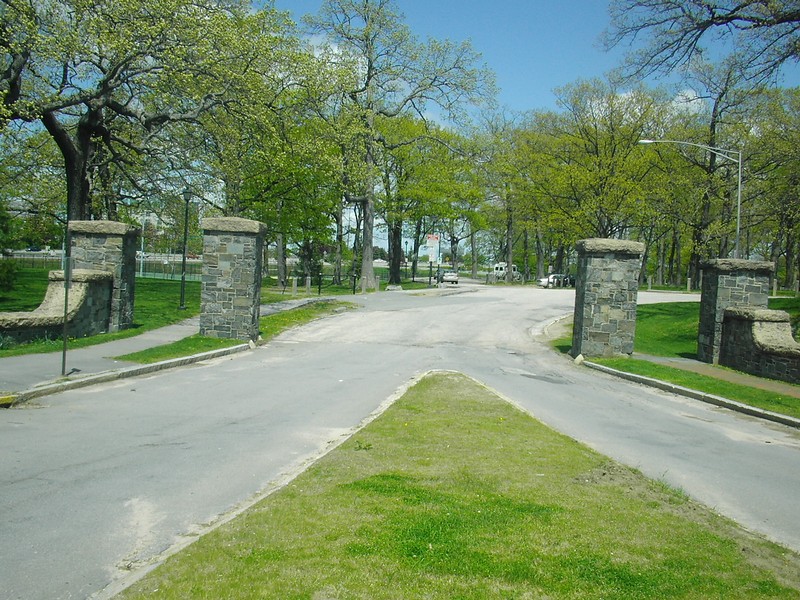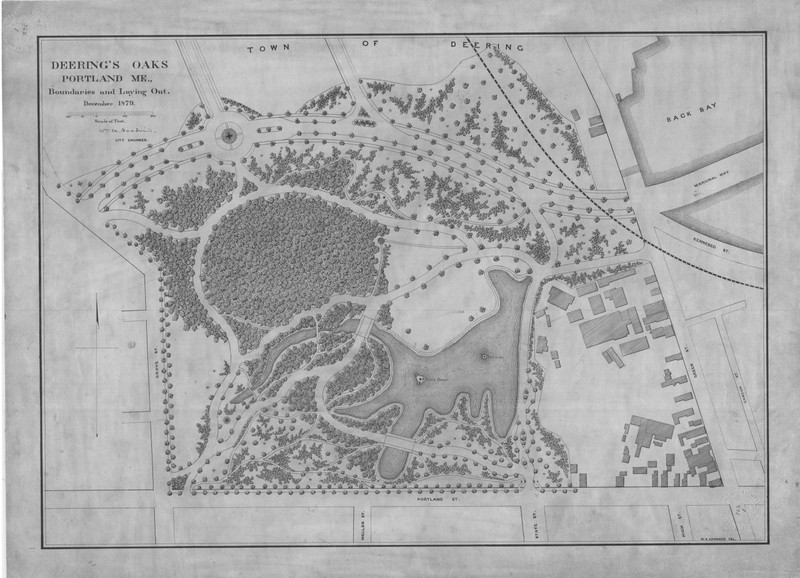Deering Oaks Park
Introduction
Text-to-speech Audio
Images
The Entrance to Deering Oaks by Namiba at Wikipedia English Foundation

The 1879 map of Deering Oaks, made available by the Friends of Deering Oaks

Backstory and Context
Text-to-speech Audio
Deering Oaks, as its name hints, was once the property of the prominent Deering family of Portland, Maine. At the time, Deering Oaks stretched between Portland Street on the south, Grove Street on the west, and Green Street and the Deering town boundary on the north. The municipal governance of Portland had sought to acquire the stretch of land for some time, but was unable to reach an agreement with the Deering family for the acquisition of the land until 1879. In 1875, the Deering family approached the City offering approximately fifty acres of Deering Oaks land, specifically to be used as a park for the length of its existence, in exchange for a freeze in property tax increases on their other significant land holdings. It took nearly four years for the City and the Deering family to come to a final agreement, at which point the family passed the land over to the City.
In December of 1879, City Civil Engineer William A. Goodwin laid out the design plans for turning Deering Oaks into a public park that would benefit the citizens of the city at large. Under Goodwin’s supervision, the unused stretch of land became a proper park. The edges of the park that met with the roads of Portland were lined with trees, a fountain and pond were constructed, and paths were laid throughout the park. Additionally, a bandstand was constructed in the northwestern area of the park.
Goodwin’s overall goal with the park, however, was to ensure the protection of the great oak trees that had given the park its name. His goal has largely been carried out. Only a few major constructions have been taken in the park, and only one of them, the State’s construction of Interstate 295, significantly encroached on the old woods that had made the site so desirable. Even the encroachment of the highway did not actually cut through the woods, instead cutting across the northern end of the park. This area of the park has been built up with plant life to screen the sounds and visuals of the highway.
In 1894, a waiting room was constructed which was later upgraded, in 1908, to contain proper toilet facilities. This waiting room was intended for use by ice skaters on the pond nearby, and became known as Castle-in-the-Park for its Victorian styling. Another major improvement to the park was made in 1902, which consisted of the construction of a grand, ornamental gateway on the State Street entrance to the park. The next significant construction that would affect the site was the aforementioned construction of Interstate 295, which occurred in 1970s.
The historical significance of the park has continued into the current day. Notably, in 2010, Deering Oaks Park was the site of a major rally pushing for the repeal of the “Don’t ask, don’t tell” policy that was held by the United States Military until late 2011. Thousands of attendees showed up at the rally, whose speakers included major musicians and LGBT rights activists, to protest the policy that required homosexual and bisexual members of the military to remain silent and discreet about their sexuality at all times.
Deering Oaks Park is now cared for by the Friends of Deering Oaks, and is the home of the Portland Farmers’ Market. To this day, it still serves the City as a public park for all citizens to enjoy.
Sources
Deering Oaks NRHP Nomination. National Park Service. September 15, 1989. Accessed July 17, 2017. https://npgallery.nps.gov/pdfhost/docs/NRHP/Text/89001708.pdf. Official documentation of NRHP Nomination for Deering Oaks
Deering Oaks. Wikipedia.org. Accessed July 17, 2017. https://en.wikipedia.org/wiki/Deering_Oaks. Meta-source for general information on Deering Oaks
Don't Ask, Don't Tell. Wikipedia.org. Accessed July 18, 2017. https://en.wikipedia.org/wiki/Don't_ask,_don't_tell. Meta-source for general information on the military policy DADT
